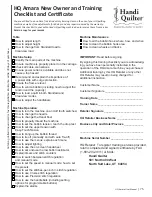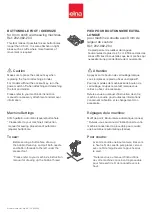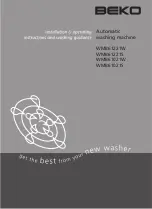
HQ Amara User Manual
| 65
Troubleshooting
You can correct many problems on your own. If you need additional help, contact your local, authorized
Handi Quilter representative. You can also contact Handi Quilter technical solutions at 1-801-292-7988 or
1-877-MY-QUILT (697-8458).
First check the following:
1. The AC power cord is properly connected and both power switches are turned on.
2. Confirm that all cables are properly seated into their connections.
3. Turn off the machine completely. Wait for at least ten seconds and then turn it back on.
If the above checks did not solve the problem, refer to the information below.
Skipped Stitches
Corrective Measure(s)
The needle is damaged, dull,
bent, or installed improperly
• Replace the needle often, normally once or twice per day for
continuous quilting or at least once per quilt. Use only the
recommended needle system.
• Always change the needle if the needle has struck any hard object
such as a pin, etc. The tip of the needle can become damaged
or burred, resulting in fabric damage as well as skipped stitches,
thread breakage, or shredding.
• Always change the needle if it has been hit, bumped or pulled off
center while maneuvering the machine over the quilt. A slightly
bent needle can be a major cause of skipped stitches.
Incorrect needle size
• Use the proper size needle for the work and thread being used.
Some battings and fabrics used in quilting may constrict or impede
the thread passing through the front groove of the needle. This
diminishes the loop required for stitch formation. Typically, a
larger needle will solve the problem. However, using certain
smaller sizes of needles and ball pointed needles solve some
specific problems. You will need to experiment to determine which
works best with your combination of fabric, thread, and batting.
Fabric is too tight on the frame
• Loosen the pole tension on the frame. Fabric that is tensioned too
tightly causes the fibers to separate and the fabric to bounce while
quilting. This reduces the needle friction on the thread, resulting
in a smaller thread loop.
Thread tension too tight
• Check bobbin case tension and then check top thread tension.
(For more information about adjusting tension, see Bobbin
and Bobbin Tension and Easy-Touch Tension™ in the Using Your
Machine section of this manual.)
Improper threading
• Ensure that the machine is threaded correctly. Refer to the
on-screen threading guide if needed.













































